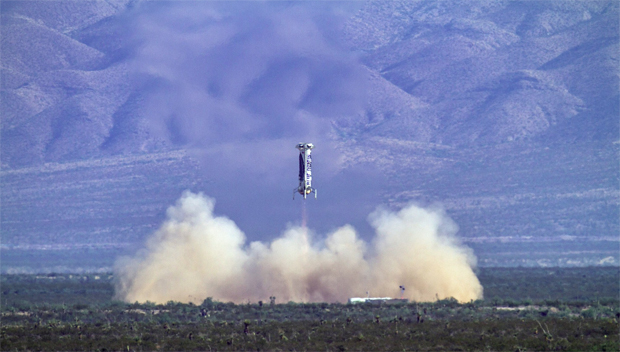Bezos' New Shepard rocket chalks up 4th test flight
Jeff Bezos' Blue Origin launched its New Shepard sub-orbital spacecraft on its fourth test flight Sunday, providing a live webcast showing the booster's tail-first rocket-powered launch and landing and the unpiloted crew capsule's descent with just two of three parachutes to demonstrate it can safely land with a major malfunction.
The well-used booster landed right on target and the capsule, designed to land safely with just one deployed parachute, appeared to be in good shape after touching down in a cloud of dust under two main chutes. It was the company's first live webcast of a New Shepard launch.
"Watching a rocket launch (and rocket landing!) might add a little extra fun w/ kids on Father's Day," Bezos tweeted before the flight. After landing, he credited the successful test to "careful engineering" plus his "lucky" cowboy boots, which feature the Latin motto: "Gradatim Ferociter." Translation: "step by step, fiercely."
While a detailed analysis of telemetry and performance is not yet complete, the dramatic test flight, the fourth for the rocket and fifth for the capsule, appeared to meet all of Blue Origin's major objectives.
The New Shepard booster and capsule are designed to lift six passengers at a time on sub-orbital up-and-down flights out of the discernible atmosphere, to altitudes just above the generally accepted 100 kilometer, or 62-mile-high, "boundary" of space.
Once separated from the booster, crew cabin occupants will experience about four minutes of weightlessness before falling back to Earth, enjoying a spectacular view of Earth's curved limb through the largest windows ever designed for spaceflight.
As the capsule plunges back into the dense lower atmosphere, space tourists will experience up to 5 Gs of deceleration before three small drogue chutes deploy to stabilize the spacecraft. Then, three main chutes deploy and small retro rockets fire an instant before touchdown to reduce the landing velocity to just a few miles per hour.
For Sunday's test flight, the spacecraft's flight computer was programmed to deploy just two parachute strings to make sure passengers can safely land despite a parachute malfunction.
The hydrogen-fueled BE-3 engine powering the stubby New Shepard booster ignited at 10:36 a.m. EDT (GMT-4) and quickly pushed the spacecraft straight away from its West Texas launch site in rural Culberson County. Two minutes and 45 seconds later, now well above 200,000 feet, the BE-3 shut down and the spacecraft, still coasting upward, began slowing down.
A few moments later, the crew capsule was released to fly on its own. It continued upward to a maximum altitude of 331,500 feet -- 62.8 miles -- before beginning its descent.
The booster, meanwhile, plunged back to Earth tail first, using a set of extendable speed brakes and a unique "ring fin" at the top of the rocket to maintain stability and slow down. Nearing the landing side, the BE-3 reignited, four landing legs deployed and the booster settled to a smooth touchdown near the center of the landing pad.
The crew capsule continued its own descent, released two of three drogue chutes and then two of its three main parachutes. Television views showed the capsule dropping slowly to the west Texas desert, kicking up a billowing cloud of dust at touchdown.
"Smooth landing with one chute out," Blue Origin tweeted.
It was not immediately clear if the braking rockets fired as planned an instant before landing, but after the dust settled, the capsule appeared to be in good shape in long-range camera views.


